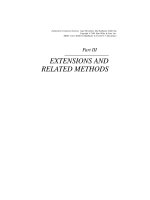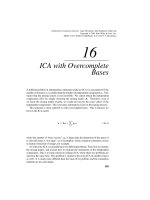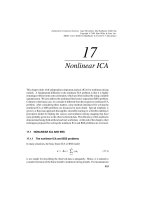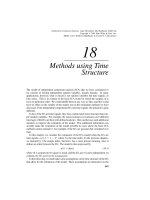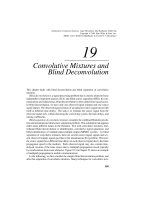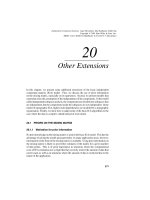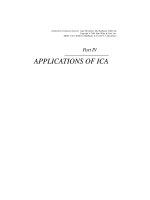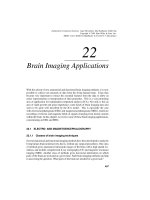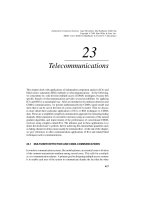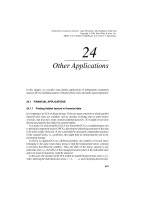Tài liệu Independent Component Analysis - Contents doc
Bạn đang xem bản rút gọn của tài liệu. Xem và tải ngay bản đầy đủ của tài liệu tại đây (189.17 KB, 26 trang )
Independent
Component
Analysis
Independent Component Analysis. Aapo Hyv
¨
arinen, Juha Karhunen, Erkki Oja
Copyright
2001 John Wiley & Sons, Inc.
ISBNs: 0-471-40540-X (Hardback); 0-471-22131-7 (Electronic)
Independent
Component
Ana&sis
Aapo Hyvtirinen
Juha Karhunen
Erkki Oja
A Wiley-Interscience Publication
JOHN WILEY & SONS, INC.
New York / Chichester / Weinheim / Brisbane / Singapore / Toronto
Designations used by companies to distinguish their products are often
claimed as trademarks. In all instances where John Wiley & Sons, Inc., is
aware of a claim, the product names appear in initial capital or ALL
CAPITAL LETTERS. Readers, however, should contact the appropriate
companies for more complete information regarding trademarks and
registration.
Copyright
2001 by John Wiley & Sons, Inc. All rights reserved.
No part of this publication may be reproduced, stored in a retrieval system
or transmitted in any form or by any means, electronic or mechanical,
including uploading, downloading, printing, decompiling, recording or
otherwise, except as permitted under Sections 107 or 108 of the 1976
United States Copyright Act, without the prior written permission of the
Publisher. Requests to the Publisher for permission should be addressed to
the Permissions Department, John Wiley & Sons, Inc., 605 Third Avenue,
New York, NY 10158-0012, (212) 850-6011, fax (212) 850-6008,
E-Mail:
This publication is designed to provide accurate and authoritative
information in regard to the subject matter covered. It is sold with the
understanding that the publisher is not engaged in rendering professional
services. If professional advice or other expert assistance is required, the
services of a competent professional person should be sought.
ISBN 0-471-22131-7
This title is also available in print as ISBN 0-471-40540-X.
For more information about Wiley products, visit our web site at
www.Wiley.com.
Contents
Preface xvii
1 Introduction 1
1.1 Linear representation of multivariate data 1
1.1.1 The general statistical setting 1
1.1.2 Dimension reduction methods 2
1.1.3 Independence as a guiding principle 3
1.2 Blind source separation 3
1.2.1 Observing mixtures of unknown signals 4
1.2.2 Source separation based on independence 5
1.3 Independent component analysis 6
1.3.1 Definition 6
1.3.2 Applications 7
1.3.3 How to find the independent components 7
1.4 History of ICA 11
v
vi
CONTENTS
Part I MATHEMATICAL PRELIMINARIES
2 Random Vectors and Independence 15
2.1 Probability distributions and densities 15
2.1.1 Distribution of a random variable 15
2.1.2 Distribution of a random vector 17
2.1.3 Joint and marginal distributions 18
2.2 Expectations and moments 19
2.2.1 Definition and general properties 19
2.2.2 Mean vector and correlation matrix 20
2.2.3 Covariances and joint moments 22
2.2.4 Estimation of expectations 24
2.3 Uncorrelatedness and independence 24
2.3.1 Uncorrelatedness and whiteness 24
2.3.2 Statistical independence 27
2.4 Conditional densities and Bayes’ rule 28
2.5 The multivariate gaussian density 31
2.5.1 Properties of the gaussian density 32
2.5.2 Central limit theorem 34
2.6 Density of a transformation 35
2.7 Higher-order statistics 36
2.7.1 Kurtosis and classification of densities 37
2.7.2 Cumulants, moments, and their properties 40
2.8 Stochastic processes * 43
2.8.1 Introduction and definition 43
2.8.2 Stationarity, mean, and autocorrelation 45
2.8.3 Wide-sense stationary processes 46
2.8.4 Time averages and ergodicity 48
2.8.5 Power spectrum 49
2.8.6 Stochastic signal models 50
2.9 Concluding remarks and references 51
Problems 52
3 Gradients and Optimization Methods 57
3.1 Vector and matrix gradients 57
3.1.1 Vector gradient 57
3.1.2 Matrix gradient 59
3.1.3 Examples of gradients 59
CONTENTS
vii
3.1.4 Taylor series expansions 62
3.2 Learning rules for unconstrained optimization 63
3.2.1 Gradient descent 63
3.2.2 Second-order learning 65
3.2.3 The natural gradient and relative gradient 67
3.2.4 Stochastic gradient descent 68
3.2.5 Convergence of stochastic on-line algorithms * 71
3.3 Learning rules for constrained optimization 73
3.3.1 The Lagrange method 73
3.3.2 Projection methods 73
3.4 Concluding remarks and references 75
Problems 75
4 Estimation Theory 77
4.1 Basic concepts 78
4.2 Properties of estimators 80
4.3 Method of moments 84
4.4 Least-squares estimation 86
4.4.1 Linear least-squares method 86
4.4.2 Nonlinear and generalized least squares * 88
4.5 Maximum likelihood method 90
4.6 Bayesian estimation * 94
4.6.1 Minimum mean-square error estimator 94
4.6.2 Wiener filtering 96
4.6.3 Maximum a posteriori (MAP) estimator 97
4.7 Concluding remarks and references 99
Problems 101
5 Information Theory 105
5.1 Entropy 105
5.1.1 Definition of entropy 105
5.1.2 Entropy and coding length 107
5.1.3 Differential entropy 108
5.1.4 Entropy of a transformation 109
5.2 Mutual information 110
5.2.1 Definition using entropy 110
5.2.2 Definition using Kullback-Leibler divergence 110
viii
CONTENTS
5.3 Maximum entropy 111
5.3.1 Maximum entropy distributions 111
5.3.2 Maximality property of gaussian distribution 112
5.4 Negentropy 112
5.5 Approximation of entropy by cumulants 113
5.5.1 Polynomial density expansions 113
5.5.2 Using expansions for entropy approximation 114
5.6 Approximation of entropy by nonpolynomial functions 115
5.6.1 Approximating the maximum entropy 116
5.6.2 Choosing the nonpolynomial functions 117
5.6.3 Simple special cases 118
5.6.4 Illustration 119
5.7 Concluding remarks and references 120
Problems 121
Appendix proofs 122
6 Principal Component Analysis and Whitening 125
6.1 Principal components 125
6.1.1 PCA by variance maximization 127
6.1.2 PCA by minimum MSE compression 128
6.1.3 Choosing the number of principal components 129
6.1.4 Closed-form computation of PCA 131
6.2 PCA by on-line learning 132
6.2.1 The stochastic gradient ascent algorithm 133
6.2.2 The subspace learning algorithm 134
6.2.3 The PAST algorithm * 135
6.2.4 PCA and back-propagation learning * 136
6.2.5 Extensions of PCA to nonquadratic criteria * 137
6.3 Factor analysis 138
6.4 Whitening 140
6.5 Orthogonalization 141
6.6 Concluding remarks and references 143
Problems 144
CONTENTS
ix
Part II BASIC INDEPENDENT COMPONENT ANALYSIS
7 What is Independent Component Analysis? 147
7.1 Motivation 147
7.2 Definition of independent component analysis 151
7.2.1 ICA as estimation of a generative model 151
7.2.2 Restrictions in ICA 152
7.2.3 Ambiguities of ICA 154
7.2.4 Centering the variables 154
7.3 Illustration of ICA 155
7.4 ICA is stronger that whitening 158
7.4.1 Uncorrelatedness and whitening 158
7.4.2 Whitening is only half ICA 160
7.5 Why gaussian variables are forbidden 161
7.6 Concluding remarks and references 163
Problems 164
8 ICA by Maximization of Nongaussianity 165
8.1 “Nongaussian is independent” 166
8.2 Measuring nongaussianity by kurtosis 171
8.2.1 Extrema give independent components 171
8.2.2 Gradient algorithm using kurtosis 175
8.2.3 A fast fixed-point algorithm using kurtosis 178
8.2.4 Examples 179
8.3 Measuring nongaussianity by negentropy 182
8.3.1 Critique of kurtosis 182
8.3.2 Negentropy as nongaussianity measure 182
8.3.3 Approximating negentropy 183
8.3.4 Gradient algorithm using negentropy 185
8.3.5 A fast fixed-point algorithm using negentropy 188
8.4 Estimating several independent components 192
8.4.1 Constraint of uncorrelatedness 192
8.4.2 Deflationary orthogonalization 194
8.4.3 Symmetric orthogonalization 194
8.5 ICA and projection pursuit 197
8.5.1 Searching for interesting directions 197
8.5.2 Nongaussian is interesting 197
8.6 Concluding remarks and references 198
x
CONTENTS
Problems 199
Appendix proofs 201
9 ICA by Maximum Likelihood Estimation 203
9.1 The likelihood of the ICA model 203
9.1.1 Deriving the likelihood 203
9.1.2 Estimation of the densities 204
9.2 Algorithms for maximum likelihood estimation 207
9.2.1 Gradient algorithms 207
9.2.2 A fast fixed-point algorithm 209
9.3 The infomax principle 211
9.4 Examples 213
9.5 Concluding remarks and references 214
Problems 218
Appendix proofs 219
10 ICA by Minimization of Mutual Information 221
10.1 Defining ICA by mutual information 221
10.1.1 Information-theoretic concepts 221
10.1.2 Mutual information as measure of dependence 222
10.2 Mutual information and nongaussianity 223
10.3 Mutual information and likelihood 224
10.4 Algorithms for minimization of mutual information 224
10.5 Examples 225
10.6 Concluding remarks and references 225
Problems 227
11 ICA by Tensorial Methods 229
11.1 Definition of cumulant tensor 229
11.2 Tensor eigenvalues give independent components 230
11.3 Tensor decomposition by a power method 232
11.4 Joint approximate diagonalization of eigenmatrices 234
11.5 Weighted correlation matrix approach 235
11.5.1 The FOBI algorithm 235
11.5.2 From FOBI to JADE 235
11.6 Concluding remarks and references 236
Problems 237
CONTENTS
xi
12 ICA by Nonlinear Decorrelation and Nonlinear PCA 239
12.1 Nonlinear correlations and independence 240
12.2 The H
´
erault-Jutten algorithm 242
12.3 The Cichocki-Unbehauen algorithm 243
12.4 The estimating functions approach * 245
12.5 Equivariant adaptive separation via independence 247
12.6 Nonlinear principal components 249
12.7 The nonlinear PCA criterion and ICA 251
12.8 Learning rules for the nonlinear PCA criterion 254
12.8.1 The nonlinear subspace rule 254
12.8.2 Convergence of the nonlinear subspace rule * 255
12.8.3 Nonlinear recursive least-squares rule 258
12.9 Concluding remarks and references 261
Problems 262
13 Practical Considerations 263
13.1 Preprocessing by time filtering 263
13.1.1 Why time filtering is possible 264
13.1.2 Low-pass filtering 265
13.1.3 High-pass filtering and innovations 265
13.1.4 Optimal filtering 266
13.2 Preprocessing by PCA 267
13.2.1 Making the mixing matrix square 267
13.2.2 Reducing noise and preventing overlearning 268
13.3 How many components should be estimated? 269
13.4 Choice of algorithm 271
13.5 Concluding remarks and references 272
Problems 272
14 Overview and Comparison of Basic ICA Methods 273
14.1 Objective functions vs. algorithms 273
14.2 Connections between ICA estimation principles 274
14.2.1 Similarities between estimation principles 274
14.2.2 Differences between estimation principles 275
14.3 Statistically optimal nonlinearities 276
14.3.1 Comparison of asymptotic variance * 276
14.3.2 Comparison of robustness * 277
14.3.3 Practical choice of nonlinearity 279
xii
CONTENTS
14.4 Experimental comparison of ICA algorithms 280
14.4.1 Experimental set-up and algorithms 281
14.4.2 Results for simulated data 282
14.4.3 Comparisons with real-world data 286
14.5 References 287
14.6 Summary of basic ICA 287
Appendix Proofs 289
Part III EXTENSIONS AND RELATED METHODS
15 Noisy ICA 293
15.1 Definition 293
15.2 Sensor noise vs. source noise 294
15.3 Few noise sources 295
15.4 Estimation of the mixing matrix 295
15.4.1 Bias removal techniques 296
15.4.2 Higher-order cumulant methods 298
15.4.3 Maximum likelihood methods 299
15.5 Estimation of the noise-free independent components 299
15.5.1 Maximum a posteriori estimation 299
15.5.2 Special case of shrinkage estimation 300
15.6 Denoising by sparse code shrinkage 303
15.7 Concluding remarks 304
16 ICA with Overcomplete Bases 305
16.1 Estimation of the independent components 306
16.1.1 Maximum likelihood estimation 306
16.1.2 The case of supergaussian components 307
16.2 Estimation of the mixing matrix 307
16.2.1 Maximizing joint likelihood 307
16.2.2 Maximizing likelihood approximations 308
16.2.3 Approximate estimation by quasiorthogonality 309
16.2.4 Other approaches 311
16.3 Concluding remarks 313
CONTENTS
xiii
17 Nonlinear ICA 315
17.1 Nonlinear ICA and BSS 315
17.1.1 The nonlinear ICA and BSS problems 315
17.1.2 Existence and uniqueness of nonlinear ICA 317
17.2 Separation of post-nonlinear mixtures 319
17.3 Nonlinear BSS using self-organizing maps 320
17.4 A generative topographic mapping approach * 322
17.4.1 Background 322
17.4.2 The modified GTM method 323
17.4.3 An experiment 326
17.5 An ensemble learning approach to nonlinear BSS 328
17.5.1 Ensemble learning 328
17.5.2 Model structure 329
17.5.3 Computing Kullback-Leibler cost function * 330
17.5.4 Learning procedure * 332
17.5.5 Experimental results 333
17.6 Other approaches 337
17.7 Concluding remarks 339
18 Methods using Time Structure 341
18.1 Separation by autocovariances 342
18.1.1 An alternative to nongaussianity 342
18.1.2 Using one time lag 343
18.1.3 Extension to several time lags 344
18.2 Separation by nonstationarity of variances 346
18.2.1 Using local autocorrelations 347
18.2.2 Using cross-cumulants 349
18.3 Separation principles unified 351
18.3.1 Comparison of separation principles 351
18.3.2 Kolmogoroff complexity as unifying framework 352
18.4 Concluding remarks 354
xiv
CONTENTS
19 Convolutive Mixtures and Blind Deconvolution 355
19.1 Blind deconvolution 356
19.1.1 Problem definition 356
19.1.2 Bussgang methods 357
19.1.3 Cumulant-based methods 358
19.1.4 Blind deconvolution using linear ICA 360
19.2 Blind separation of convolutive mixtures 361
19.2.1 The convolutive BSS problem 361
19.2.2 Reformulation as ordinary ICA 363
19.2.3 Natural gradient methods 364
19.2.4 Fourier transform methods 365
19.2.5 Spatiotemporal decorrelation methods 367
19.2.6 Other methods for convolutive mixtures 367
19.3 Concluding remarks 368
Appendix Discrete-time filters and the -transform 369
20 Other Extensions 371
20.1 Priors on the mixing matrix 371
20.1.1 Motivation for prior information 371
20.1.2 Classic priors 372
20.1.3 Sparse priors 374
20.1.4 Spatiotemporal ICA 377
20.2 Relaxing the independence assumption 378
20.2.1 Multidimensional ICA 379
20.2.2 Independent subspace analysis 380
20.2.3 Topographic ICA 382
20.3 Complex-valued data 383
20.3.1 Basic concepts of complex random variables 383
20.3.2 Indeterminacy of the independent components 384
20.3.3 Choice of the nongaussianity measure 385
20.3.4 Consistency of estimator 386
20.3.5 Fixed-point algorithm 386
20.3.6 Relation to independent subspaces 387
20.4 Concluding remarks 387
CONTENTS
xv
Part IV APPLICATIONS OF ICA
21 Feature Extraction by ICA 391
21.1 Linear representations 392
21.1.1 Definition 392
21.1.2 Gabor analysis 392
21.1.3 Wavelets 394
21.2 ICA and Sparse Coding 396
21.3 Estimating ICA bases from images 398
21.4 Image denoising by sparse code shrinkage 398
21.4.1 Component statistics 399
21.4.2 Remarks on windowing 400
21.4.3 Denoising results 401
21.5 Independent subspaces and topographic ICA 401
21.6 Neurophysiological connections 403
21.7 Concluding remarks 405
22 Brain Imaging Applications 407
22.1 Electro- and magnetoencephalography 407
22.1.1 Classes of brain imaging techniques 407
22.1.2 Measuring electric activity in the brain 408
22.1.3 Validity of the basic ICA model 409
22.2 Artifact identification from EEG and MEG 410
22.3 Analysis of evoked magnetic fields 411
22.4 ICA applied on other measurement techniques 413
22.5 Concluding remarks 414
23 Telecommunications 417
23.1 Multiuser detection and CDMA communications 417
23.2 CDMA signal model and ICA 422
23.3 Estimating fading channels 424
23.3.1 Minimization of complexity 424
23.3.2 Channel estimation * 426
23.3.3 Comparisons and discussion 428
23.4 Blind separation of convolved CDMA mixtures * 430
23.4.1 Feedback architecture 430
23.4.2 Semiblind separation method 431
23.4.3 Simulations and discussion 432
xvi
CONTENTS
23.5 Improving multiuser detection using complex ICA * 434
23.5.1 Data model 435
23.5.2 ICA based receivers 436
23.5.3 Simulation results 438
23.6 Concluding remarks and references 439
24 Other Applications 441
24.1 Financial applications 441
24.1.1 Finding hidden factors in financial data 441
24.1.2 Time series prediction by ICA 443
24.2 Audio separation 446
24.3 Further applications 448
References 449
Index 476
Preface
Independent component analysis (ICA) is a statistical and computational technique
for revealing hidden factors that underlie sets of random variables, measurements, or
signals. ICA defines a generative model for the observed multivariate data, which is
typically given as a large database of samples. In the model, the data variables are
assumed to be linear or nonlinear mixtures of some unknown latent variables, and
the mixing system is also unknown. The latent variables are assumed nongaussian
and mutually independent, and they are called the independent components of the
observed data. These independent components, also called sources or factors, can be
found by ICA.
ICA can be seen as an extension to principal component analysis and factor
analysis. ICA is a much more powerful technique, however, capable of finding the
underlying factors or sources when these classic methods fail completely.
The data analyzed by ICA could originate from many different kinds of applica-
tion fields, including digital images and document databases, as well as economic
indicators and psychometric measurements. In many cases, the measurements are
given as a setof parallelsignals or timeseries; the termblind source separation isused
to characterize this problem. Typical examples are mixtures of simultaneous speech
signals that have been picked up by several microphones, brain waves recorded by
multiple sensors, interfering radio signals arriving at a mobile phone, or parallel time
series obtained from some industrial process.
The technique of ICA is a relatively new invention. It was for the first time in-
troduced in early 1980s in the context of neural network modeling. In mid-1990s,
some highly successful new algorithms were introduced by several research groups,
xvii
xviii
PREFACE
together with impressive demonstrations on problems like the cocktail-party effect,
where the individual speech waveforms are found from their mixtures. ICA became
one of the exciting new topics, both in the field of neural networks, especially unsu-
pervised learning, and more generally in advanced statistics and signal processing.
Reported real-world applications of ICA on biomedical signal processing, audio sig-
nal separation,telecommunications,fault diagnosis, feature extraction, financial time
series analysis, and data mining began to appear.
Many articles on ICA were published during the past 20 years in a large number
of journals and conference proceedings in the fields of signal processing, artificial
neural networks,statistics, informationtheory,and various application fields. Several
special sessions and workshops on ICA have been arranged recently [70, 348], and
some edited collections of articles [315, 173, 150] as well as some monographs on
ICA, blind source separation, and related subjects [105, 267, 149] have appeared.
However, while highly useful for their intended readership, these existing texts typ-
ically concentrate on some selected aspects of the ICA methods only. In the brief
scientific papers and book chapters, mathematical and statistical preliminaries are
usually not included, which makes it very hard for a wider audience to gain full
understanding of this fairly technical topic.
A comprehensive and detailed text book has been missing, which would cover
boththemathematicalbackground andprinciples,algorithmicsolutions,andpractical
applications of the present state of the art of ICA. The present book is intended to fill
that gap, serving as a fundamental introduction to ICA.
It is expected that the readership will be from a variety of disciplines, such
as statistics, signal processing, neural networks, applied mathematics, neural and
cognitive sciences, information theory, artificial intelligence, and engineering. Both
researchers, students, and practitioners will be able to use the book. We have made
everyeffortto makethis bookself-contained, so that areader witha basic background
in college calculus, matrix algebra, probability theory, and statistics will be able to
read it. This book is also suitable for a graduate level university course on ICA,
which is facilitated by the exercise problems and computer assignments given in
many chapters.
Scope and contents of this book
This book provides a comprehensive introduction to ICA as a statistical and compu-
tational technique. The emphasis is on the fundamental mathematical principles and
basic algorithms. Much of the material is based on the original research conducted
in the authors’ own research group, which is naturally reflected in the weighting of
the different topics. We give a wide coverage especially to those algorithms that are
scalable to large problems, that is, work even with a large number of observed vari-
ables and data points. These will be increasingly used in the near future when ICA
is extensively applied in practical real-world problems instead of the toy problems
or small pilot studies that have been predominant until recently. Respectively, some-
PREFACE
xix
what less emphasis is given to more specialized signal processing methods involving
convolutivemixtures, delays, and other blind source separation techniques than ICA.
As ICA is a fast growing research area, it is impossible to include every reported
development in a textbook. We have tried to cover the central contributions by other
workers in the field in their appropriate context andpresent an extensive bibliography
for further reference. We apologize for any omissions of important contributionsthat
we may have overlooked.
For easier reading, the book is divided into four parts.
Part I gives the mathematical preliminaries. It introduces the general math-
ematical concepts needed in the rest of the book. We start with a crash course
on probability theory in Chapter 2. The reader is assumed to be familiar with
most of the basic material in this chapter, but also some concepts more spe-
cific to ICA are introduced, such as higher-order cumulants and multivariate
probability theory. Next, Chapter 3 discusses essential concepts in optimiza-
tion theory and gradient methods, which are needed when developing ICA
algorithms. Estimation theory is reviewed in Chapter 4. A complementary
theoretical framework for ICA is information theory, covered in Chapter 5.
Part I is concluded by Chapter 6, which discusses methods related to principal
component analysis, factor analysis, and decorrelation.
More confident readers may prefer to skip some or all of the introductory
chapters in Part I and continue directly to the principles of ICA in Part II.
In Part II, the basic ICA model is covered and solved. This is the linear
instantaneousnoise-freemixingmodelthat is classicin ICA,andformsthe core
of the ICAtheory. The modelis introducedand the questionof identifiability of
the mixing matrix is treatedin Chapter 7. The followingchapters treat different
methods of estimating the model. A central principle is nongaussianity,whose
relationto ICA is first discussed in Chapter8. Next, theprinciplesof maximum
likelihood (Chapter 9) and minimum mutual information (Chapter 10) are
reviewed, and connections between these three fundamental principles are
shown. Material that is less suitable for an introductory course is covered
in Chapter 11, which discusses the algebraic approach using higher-order
cumulant tensors, and Chapter 12, which reviews the early work on ICA based
on nonlinear decorrelations, as well as the nonlinear principal component
approach. Practical algorithms for computing the independent components
and the mixing matrix are discussed in connection with each principle. Next,
some practical considerations, mainly related to preprocessing and dimension
reduction ofthe dataarediscussedin Chapter13,including hintstopractitioners
on howto really apply ICAto theirownproblem. An overviewand comparison
of the various ICA methods is presented in Chapter 14, which thus summarizes
Part II.
In PartIII, differentextensions ofthebasicICA modelare given. This partisby
its nature more speculative than Part II, since most of the extensionshave been
introduced very recently, and many open problems remain. In an introductory
xx
PREFACE
course on ICA, only selected chapters from this part may be covered. First,
in Chapter 15, we treat the problem of introducing explicit observational noise
in the ICA model. Then the situation where there are more independent
components than observed mixtures is treated in Chapter 16. In Chapter 17,
the model is widely generalized to the case where the mixing process can be of
a very general nonlinear form. Chapter 18 discusses methods that estimate a
linear mixing model similar tothat ofICA, butwith quitedifferentassumptions:
the components are not nongaussianbut have some time dependenciesinstead.
Chapter 19 discusses the case where the mixing system includes convolutions.
Further extensions, in particular models where the components are no longer
required to be exactly independent, are given in Chapter 20.
Part IV treats some applications of ICA methods. Feature extraction (Chap-
ter 21) is relevant to both image processing and vision research. Brain imaging
applications (Chapter 22) concentrate on measurements of the electrical and
magnetic activity of the human brain. Telecommunications applications are
treated in Chapter 23. Some econometric and audio signal processing applica-
tions, together with pointers to miscellaneous other applications, are treated in
Chapter 24.
Throughout the book, we have marked with an asterisk some sections that are
rather involved and can be skipped in an introductory course.
Several of the algorithms presented in this book are available as public domain
software through the World Wide Web, both on our own Web pages and those of
other ICA researchers. Also, databases of real-world data can be found there for
testing the methods. We have made a special Web page for this book, which contains
appropriate pointers. The address is
www.cis.hut.fi/projects/ica/book
The reader is advised to consult this page for further information.
This book was written in cooperation between the three authors. A. Hyv
¨
arinen
was responsible for the chapters 5, 7, 8, 9, 10, 11, 13, 14, 15, 16, 18, 20, 21, and 22;
J. Karhunen was responsible for the chapters 2, 4, 17, 19, and 23; while E. Oja was
responsible for the chapters 3, 6, and 12. The Chapters 1 and 24 were written jointly
by the authors.
Acknowledgments
We are grateful to the many ICA researchers whose original contributions form the
foundations of ICA and who have made this book possible. In particular, we wish to
expressour gratitude to the Series Editor Simon Haykin, whose articles and bookson
signal processing and neural networks have been an inspiration to us over the years.
PREFACE
xxi
Some parts of this text are based on close cooperation with other members of our
research group at the Helsinki University of Technology. Chapter 21 is largely based
on joint work with Patrik Hoyer, who also made all the experiments in that chapter.
Chapter 22 is based on experiments and material by Ricardo Vig
´
ario. Section 13.2.2
is based on joint work with Jaakko S
¨
arel
¨
a and Ricardo Vig
´
ario. The experiments in
Section 16.2.3 were provided by Razvan Cristescu. Section 20.3 is based on joint
work with Ella Bingham, Section 14.4 on joint work with Xavier Giannakopoulos,
and Section 20.2.3 on joint work with Patrik Hoyer and Mika Inki. Chapter 19 is
partly based on material provided by Kari Torkkola. Much of Chapter 17 is based
on joint work with Harri Valpola and Petteri Pajunen, and Section 24.1 is joint work
with Kimmo Kiviluoto and Simona Malaroiu.
Over various phases of writing this book, several people have kindly agreed to
read and commenton parts or all of the text. We are grateful for this to Ella Bingham,
Jean-Franc¸ois Cardoso, Adrian Flanagan, Mark Girolami, Antti Honkela, Jarmo
Hurri, Petteri Pajunen, Tapani Ristaniemi, and Kari Torkkola. Leila Koivisto helped
in technical editing, while Antti Honkela, Mika Ilmoniemi, Merja Oja, and Tapani
Raiko helped with some of the figures.
Our original research work on ICA as well as writing this book has been mainly
conductedatthe Neural NetworksResearchCentreoftheHelsinkiUniversityofTech-
nology, Finland. The research had been partly financed by the project “BLISS” (Eu-
ropean Union) and the project “New Information Processing Principles” (Academy
of Finland), which are gratefully acknowledged. Also, A. H. wishes to thank G
¨
ote
Nyman and Jukka H
¨
akkinen of the Department of Psychology of the University of
Helsinki who hosted his civilian service there and made part of the writing possible.
AAPO HYV
¨
ARINEN,JUHA KARHUNEN,ERKKI OJA
Espoo, Finland
March 2001
Index
Akaike’s information criterion, 131
Algorithm
AMUSE, 343
Bell-Sejnowski, 207
Cichocki-Unbehauen, 244
EASI, 247
eigenvalue decomposition
of cumulant tensor, 230
of weighted correlation, 235
fixed-point (FastICA)
for complex-valued data, 386
for maximum likelihood estimation, 209
for tensor decomposition, 232
using kurtosis, 178
using negentropy, 188
FOBI, 235
gradient
for maximum likelihood estimation, 207
using kurtosis, 175
using negentropy, 185
Herault-Jutten, 242
JADE, 234
natural gradient
for maximum likelihood estimation, 208, 430
nonlinear RLS, 259
SOBI, 344
TDSEP, 344
Algorithms
experimental comparison, 280
choice of, 271
connections between, 274
effect of noise, 286
performance index, 281
vs. objective functions, 273
AMUSE, 343
APEX, 135
Applications
audio separation, 446
brain imaging, 407
brain modeling, 403
communications, 358, 417
econometric, 441
financial, 441
image denoising, 398
image feature extraction, 311, 391
industrial process monitoring, 335
miscellaneous, 448
vision research, 403
visualization, 197
ARMA process, 51
Artifacts
in EEG and MEG, 410
Asymptotic variance, 276
Autoassociative learning, 136, 249
Autocorrelations, 45, 47
as an alternative to nongaussianity, 342
ICA estimation using, 342
in telecommunications, 424
Autoregressive (AR) process, 50, 445
Back-propagation learning, 136
476
INDEX
477
Basis vectors
and factor rotation, 268
Gabor, 394
ICA, 398
in overcomplete ICA, 305
of independent subspace, 380
of PCA subspace, 128
relation to filters in ICA, 396
wavelet, 396
Batch learning, 69
Bayes’ rule, 31
Bias, 80
Blind deconvolution, 355–356
multichannel, 355, 361
Bussgang methods, 357
CMA algorithm, 358
cumulant-based methods, 358
Godard algorithm, 357
Shalvi-Weinstein algorithm, 359
using linear ICA, 360
Blind equalization, see blind deconvolution
Blind source separation, 147
Brain imaging, 407
Bussgang criterion, 253
CDMA (Code Division Multiple Access), 417
CDMA signal model, 422
Centering, 154
Central limit theorem, 34, 166
Central moment, 37, 84
Characteristic function, 41
Chip sequence, 418
Cichocki-Unbehauen algorithm, 244
Cocktail-party problem, 147, 361, 446
Code length
and entropy, 107
and Kolmogoroff complexity, 352
and mutual information, 110
Complex-valued data, 383
Complexity minimization, 353, 424
Compression
by PCA, 126
Conjugate gradients, 67
Consistency, 80
of ICA methods, 187, 205
Convergence
of on-line algorithms, 71
speed, 65
Convolution, 369
Convolutive mixtures, 355, 361
application in CDMA, 430
Bussgang type methods, 367
Fourier transform methods, 365
natural gradient methods, 364
using autocovariances, 367
using higher-order statistics, 367
using spatiotemporal decorrelation, 367
Correlation matrix, 21–22, 26, 48
Correlation, 21
and independence, 240
nonlinear, 240
Covariance matrix, 22
of estimation error, 82, 95
Covariance, 22
Cramer-Rao lower bound, 82, 92
Cross-correlation function, 46
Cross-correlation matrix, 22
Cross-covariance function, 46
Cross-covariance matrix, 23
Cross-cumulants, 42
Cumulant generating function, 41
Cumulant tensor, 229
Cumulants, 41–42
Cumulative distribution function, 15, 17, 27, 36
joint, 19
Curve fitting, 87
Cyclostationarity, 368
Decorrelation, 132, 140
nonlinear, 239–240, 244
Denoising of images, 398
Density, see probability density
Density expansions
Edgeworth, 113
Gram-Charlier, 113
polynomial, 113
Discrete-valued components, 261, 299, 311
Distribution, see probability density
EASI algorithm, 247
Edgeworth expansion, 113
EEG, 407
Electrocardiography, 413
Electroencephalography, 407
EM algorithm, 93
Ensemble learning, 328
Entropy, 222
approximation, 113, 115
by cumulants, 113
by nonpolynomial functions, 115
definition, 105
differential, 108
maximality of gaussian distribution, 112
maximum, 111
of transformation, 109
Equivariance, 248
Ergodicity, 49
Error criterion, 81
Estimate, 78
Estimating function, 245
Estimation, 77
adaptive, 79
asymptotically unbiased, 80
batch, 79
Bayesian, 79, 94
478
INDEX
consistent, 80
efficient, 82
error, 80
linear minimum MSE error, 95
maximum a posteriori (MAP), 97
maximum likelihood, 90
minimum mean-square error, 94, 428, 433
moment, 84
of expectation, 24
off-line, 79
on-line, 79
recursive, 79
robust, 83
unbiased, 80
Estimator, see estimation (for general entry);
algorithm (for ICA entry)
Evoked fields, 411
Expectation, 19
conditional, 31
properties, 20
Expectation-maximization (EM) algorithm, 322
Factor analysis, 138
and ICA, 139, 268
nonlinear independent, 332
nonlinear, 332
principal, 138
Factor rotation, 139–140, 268
FastICA
for complex-valued data, 437
for maximum likelihood estimation, 209
for tensor decomposition, 232
using kurtosis, 178
using negentropy, 188
Feature extraction
by ICA, 150, 398
by independent subspace analysis, 401
by topographic ICA, 401
using overcomplete bases, 311
Feedback architecture, 431
Filtering
high-pass, 265
linear, 96
low-pass, 265
optimal, 266
taking innovation processes, 266
Wiener, 96
Financial time series, 441
FIR filter, 369
Fisher information matrix, 83
Fixed-point algorithm, see FastICA
FMRI, 407, 413
FOBI, 235
Fourier transform, 370
Fourth-order blind identification, 235
Gabor analysis, 392
and ICA, 398
Gauss-Newton method, 67
Gaussian density, 16
forbidden in ICA, 161
multivariate, 31
properties, 32
Generalized Hebbian algorithm (GHA), 134
Generative topographic mapping (GTM), 322
Gradient descent
deterministic, 63
stochastic, 68
Gradient, 57
natural, 67, 208, 244, 247
of function, 57
relative, 67, 247
Gram-Charlier expansion, 113
Gram-Schmidt orthogonalization, 141
Herault-Jutten algorithm, 242
Hessian matrix, 58
Higher-order statistics, 36
ICA
ambiguities in, 154
complex-valued case, 384
and factor rotation, 140, 268
and feature extraction, 398
definition, 151
identifiability, 152, 154
complex-valued case, 384
multidimensional, 379
noisy, 293
overview of estimation principles, 287
restrictions in, 152
spatiotemporal, 377
topographic, 382
applications on images, 401
with complex-valued data, 383, 435
with convolutive mixtures, 355, 361, 430
with overcomplete bases, 305–306
with subspaces, 380
IIR filter, 369
Independence, 27, 30, 33
Independent component analysis, see ICA
Independent subspace analysis, 380
and complex-valued data, 387
applications on images, 401
Infomax, 211, 430
Innovation process, 266
Intersymbol interference (ISI), 420
Jacobian matrix, 58
JADE, 234
Jeffreys’ prior, 373
Joint approximate diagonalization, 234
Karhunen-Lo
`
eve transform, 143
Kolmogoroff complexity, 351, 424–425
Kullback-Leibler divergence, 110
Kurtosis, 38
as nongaussianity measure, 171
INDEX
479
nonrobustness, 182, 184
relation with nonlinear PCA, 252
Lagrange method, 73
Laplacian density, 39, 171
Learning
algorithms, 63
batch, 69
on-line, 69
rate, 63
Least mean-square error, 249
Least-squares method, 86
generalized, 88
linear, 86
nonlinear, 89, 93
normal equations, 87
Likelihood, 90
and mutual information, 224
and nonlinear PCA, 253
and posterior density, 97
of ICA model, 203
See also maximum likelihood
Loss function, 81
Magnetic resonance imaging, 407, 413
Magnetoencephalography, 407
Magnetoneurography, 413
MAP, see maximum a posteriori
Marquardt-Levenberg algorithm, 67
Matched filter, 424, 432
Matrix
determinant, 61
gradient of function, 59
Jacobian, 36
trace, 62
Maximization of function, 57
Maximum a posteriori, 97, 299, 303, 306, 326
Maximum entropy, 111
Maximum likelihood, 90, 203, 322
consistency of, 205
in CDMA, 424
See also likelihood
Mean function, 45
Mean vector, 21
Mean-square error, 81, 94
minimization for PCA, 128
MEG, 407
Minimization of function, 57
Minimum description length, 131
Minimum-phase filter, 370
Minor components, 135
Mixture of gaussians, 322, 329
ML, see maximum likelihood
MMSE estimator, 424
MMSE-ICA detector, 434, 437–438
Model order
choosing, 131, 271
Modified GTM method, 323
Moment generating function, 41
Moment method, 84
Moments, 20, 37, 41–42
central, 22
nonpolynomial, 207
Momentum term, 426
Moving average (MA) process, 51
Multilayer perceptron, 136, 328
Multipath propagation, 420
Multiple access communications, 417
Multiple access interference (MAI), 421
Multiuser detection, 421
Mutual information, 221–222, 319
and Kullback-Leibler divergence, 110
and likelihood, 224
and nongaussianity, 223
approximation of, 223–224
definition, 110
minimization of, 221
Near–far problem, 421, 424
Negentropy, 222
approximation, 113, 115, 183
by cumulants, 113
by nonpolynomial functions, 115
as measure of nongaussianity, 182
as nongaussianity measure, 182
definition, 112
optimality, 277
Neural networks, 36
Neurons, 408
Newton’s method, 66
Noise, 446
as independent components, 295
in the ICA model, 293
reduction by low-pass filtering, 265
reduction by nonlinear filtering, 300
reduction by PCA, 268
reduction by shrinkage, 300
application on images, 398
sensor vs. source, 294
Noisy ICA
application
image processing, 398
telecommunications, 423
estimation of ICs, 299
by MAP, 299
by maximum likelihood, 299
by shrinkage, 300
estimation of mixing matrix, 295
bias removal techniques, 296
by cumulant methods, 298
by FastICA, 298
by maximum likelihood, 299
Nongaussianity, 165
and projection pursuit, 197
is interesting, 197
480
INDEX
measured by kurtosis, 171, 182
measured by negentropy, 182
optimal measure is negentropy, 277
Nonlinear BSS, 315
definition, 316
Nonlinear ICA, 315
definition, 316
existence and uniqueness, 317
post-nonlinear mixtures, 319
using ensemble learning, 328
using modified GTM method, 323
using self-organizing map (SOM), 320
Nonlinear mixing model, 315
Nonlinearity in algorithm
choice of, 276, 280
Nonstationarity
and tracking, 72, 133, 135, 178
definition, 46
measuring by autocorrelations, 347
measuring by cross-cumulants, 349
separation by, 346
Oja’s rule, 133
On-line learning, 69
Optical imaging, 413
Optimization methods, 57
constrained, 73
unconstrained, 63
Order statistics, 226
Orthogonalization, 141
Gram-Schmidt, 141
symmetric, 142
Overcomplete bases
and image feature extraction, 311
estimation of ICs, 306
by maximum likelihood, 306
estimation of mixing matrix, 307
by FastICA, 309
by maximum likelihood, 307
Overlearning, 268
and PCA, 269
and priors on mixing, 371
Parameter vector, 78
PAST, 136
Performance index, 81
PET, 407
Positive semidefinite, 21
Post-nonlinear mixtures, 316
Posterior, 94
Power method
higher-order, 232
Power spectrum, 49
Prediction of time series, 443
Preprocessing, 263
by PCA, 267
centering, 154
filtering, 264
whitening, 158
Principal component analysis, 125, 332
and complexity, 425
and ICA, 139, 249, 251
and whitening, 140
by on-line learning, 132
closed-form computation, 132
nonlinear, 249
number of components, 129
with nonquadratic criteria, 137
Principal curves, 249
Prior, 94
conjugate, 375
for mixing matrix, 371
Jeffreys’, 373
quadratic, 373
sparse, 374
for mixing matrix, 375
Probability density, 16
a posteriori, 94
a priori, 94
conditional, 28
double exponential, 39, 171
gaussian, 16, 42
generalized gaussian, 40
joint, 19, 22, 27, 30, 45
Laplacian, 39, 171
marginal, 19, 27, 29, 33
multivariate, 17
of a transformation, 35
posterior, 31, 328
prior, 31
uniform, 36, 39, 171
Projection matrix, 427
Projection method, 73
Projection pursuit, 197, 286
Pseudoinverse, 87
Quasiorthogonality, 310
in FastICA, 310
RAKE detector, 424, 434, 437–438
RAKE-ICA detector, 434, 438
Random variable, 15
Random vector, 17
Recursive least-squares
for nonlinear PCA, 259
for PCA, 135
Robustness, 83, 182, 277
Sample mean, 24
Sample moment, 84
Self-organizing map (SOM), 320
Semiblind methods, 387, 424, 432
Semiparametric, 204
Skewness, 38
Smoothing, 445
SOBI, 344
Sparse code shrinkage, 303, 398
